You ll Need to Slide the Weight Poises Until the Pointer Is at Zero Again
Please ensure your browser's zoom is set to 100% for optimal viewing.

Features:
A low price, maintenance-complimentary balance which provides all the convenience of a top loader, withal retains the ruggedness needed for a wide range of lab piece of work. Tiered axle visibility and zilch adjust combine to give high speed performance and reduce error. Magnetic damping speeds up weighing by causing the beam to come to balance quickly without affecting sensitivity or accurateness. Optional zipper weights shop conveniently in the base when non in use. Capacity: with attachment weights = 2610g (five lb. 2 oz.), without attachment weights = 610g (1lb. 2oz.).

Unpacking:
Carefully remove the residuum and the separate poise (slide weight) from the protective carton. Yous will discover a slit rubber washer lodged underneath the platform, and one rubber washer located above the pointer. The washers are to be removed from the scale.
ACTION: Click and elevate the washers to remove them from the calibration.
Packing Listing
a) balance
b) 100g poise
c) ii-1000g attachment weights*
d) i-500g attachment weight*
e) instruction manual
*Included with TP2611 model
Set-upward:
Later placing the balance on a shine, apartment surface, slide the separate poise up into the slot on the back of the middle beam. This slot is located betwixt the 400 and 500 g marks on the lesser of the beam.
ACTION: Click and elevate the 100g weight upward onto the heart beam.

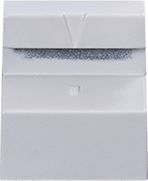



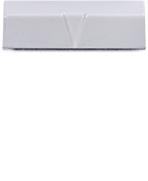
Care and Maintenance:
Go along balance make clean at all times. In full general, most foreign matter may be easily removed by an air syringe. If foreign affair collects around the damping magnets it can be removed by pressing adhesive-backed tape on the magnet surfaces. Never utilise lubricants to knives or bearings, nor allow foreign matter to accumulate. Corrosive materials should never be placed straight on the platform since permanent impairment could outcome.




Transporting the Balance:
When moving the residue it is essential that you lot protect the vital parts of the instrument. This is done by placing i hand under the residual base and holding the pan support with the thumb and forefinger between the pan associates and base. This action lifts the pocketknife blades from their bearing and thus prevents difficult from jarring or stronger bumps.
For major relocations we suggest that you reinstall the prophylactic washers that were removed when the unit was initially unpacked.


Every time you wish to weigh an item on the Triple Axle Residuum, you must first "zero" the residual. This sets the scale of the balance to zero and volition ensure that the proper reading will result.
ACTION: Use the Next pointer to continue to the next instruction.
Step one: Remove any objects from the platform.
Activeness: Click and drag the beaker to remove it from the platform.
Stride 2: Remove any attachment weights from the end of the beams.
Action: Click and drag the weight to remove it from the end of the beam.
Pace 3: Set all 3 weight poises to the zero setting.
Activeness: Click and drag each weight poise to its zero position on the left.
The residual is at present ready to zero.
Activity: Click the Side by side push to proceed.
The nil aligning knob tin be found on the far left side of the master balancing arm. If it is turned clockwise, the rest index arrow will lower. If turned counter clockwise, the alphabetize pointer will ascension.
The object is to turn the zero knob until the index pointer points to zero.
In the example shown, the alphabetize arrow is beneath the zero mark, thus the nix adjust knob needs to be turned counter clockwise.
ACTION: Click and drag the zero adjustment knob up to center the balance.
The index is now on zero and the residual is ready to weigh an unknown.
Step 1: Place the unknown in the center of the platform.
ACTION: Click and drag the unknown to the platform.
Find that the index pointer is above the zero mark indicating that the amount of weight on the platform is greater than the poises.
Activity: Click Adjacent to keep.
Step ii: Move the 100g poise to the right until the index arrow swings below the zero mark, then dorsum it up i notch.
Stride three: Repeat this process with the 10g poise.
Step 4: Slowly motility the 1g poise until the alphabetize pointer lines upwards with the zero mark.
Activeness: Elevate the poises into position until the scale balances.
The total weight can now be read from the scales.
The readings of the different scales are:
| 100g scale | = | 100g |
| 10g scale | = | 50g |
| 1g scale | = | vii.63g* |
| Total weight | = | 157.63g |
*The 100th place (iii in this instance) is an approximated value and is not read straight but estimated.

With the help of the Model 183 Clamp and Rod Support*, materials tin can be massed while suspended in water assuasive specific gravity determinations. The specimen is hung using fine wire or thread from the bottom of the platform assembly.

The support rod is inserted into a 1/2 inch recess on the underside of the base while the support is secured to a table with the clench.
*included with TP2611 model

In this do the computer will select a random mass and set the three scales to that value after clicking "New Unknown." You so read the scales and enter your value in the text box to the right making sure to approximate the second decimal place. Click the "Cheque Mass" button and the plan will compare your value to the truthful value.
One place past the decimal is read with certainty. The second identify by is estimated and considered inaccurate.





mass 1 ten gravity = mass two 10 gravity
The mechanical balance works on the principle that equal masses will be pulled down by gravity with equal force. Thus if ii equal masses are suspended past a string around a caster, they rest each other.
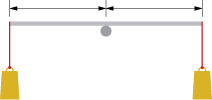
If we append the two masses from the opposite ends of a balance beam, we add some other dimension, length. This length is measured from the pivot point of the beam to where the masses are suspended. The downward pull (torque) on each side is equal to:
torque = mass ten gravity 10 length
If the torque produced on each side is equal, the weights are balanced. If we shorten the length of one side, nosotros must besides increase the mass on that side to continue counterbalanced.
ACTION: Elevate the arrow to change the length of the right side.

left side length = 164
right side length = 164
100.00


100.00
left side torque:
100.00 10 9.viii ten 164 = 160720
right side torque:
100.00 x nine.8 x 164 = 160720
The triple beam balance is built effectually this principle of a balance axle with equal torques on each side.

The torque produced by the left side of the axle (all the different masses and their distances from the pin point) equals the torque of the correct side of the beam (all the different masses and their distance from the pivot point). This is no easy task to engineer and industry. Components of the residue must exist made to exacting specs and have the ability to be slightly altered, as to their mass, to permit fine tuning of the balance. The balance cup (underneath the platform), 100 thou poise and x thou poise must all be calibrated and set during manufacturing to ensure proper mass readings.
The 3 rest beams allow for adjustable lengths of three different masses. The calibration on each beam has been prepare so that the length of the mass, from the pivot point, volition produce a specific torque that will counterbalance a specific mass on the reverse side platform. This allows the user to "read" the mass balanced.

The distance between each notch will counterbalance x g on the platform

The altitude between each notch will counterbalance 100 thou on the platform

This poise volition counterbalance whatsoever value from 0-x g in 0.one chiliad values.
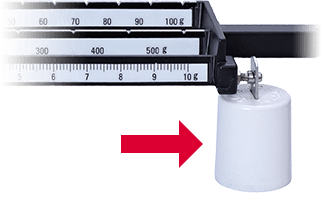 Even higher mass capacities can be reached if zipper weights are used. They take been calibrated so that their mass and their length from the pivot point will counterbalance 500 or 1000 grams. Dissimilar the poises, their position is set and thus they counterbalance a set value.
Even higher mass capacities can be reached if zipper weights are used. They take been calibrated so that their mass and their length from the pivot point will counterbalance 500 or 1000 grams. Dissimilar the poises, their position is set and thus they counterbalance a set value.
 Over time and handling the balance may no longer be at factory set balance or "nil." This zero point tin can be reestablished by using the "zip adjust" knob. This knob is on a threaded rod which allows yous to twist it inwards, shortening its length from the pivot point, or twist information technology outwards, lengthening it. This very small shift in length volition add or subtract torque from the left side of the balance.
Over time and handling the balance may no longer be at factory set balance or "nil." This zero point tin can be reestablished by using the "zip adjust" knob. This knob is on a threaded rod which allows yous to twist it inwards, shortening its length from the pivot point, or twist information technology outwards, lengthening it. This very small shift in length volition add or subtract torque from the left side of the balance.
 The "zero" signal is read by the indicator attached to the end of the right side of the residual arm.
The "zero" signal is read by the indicator attached to the end of the right side of the residual arm.
 As already pointed out, the altitude a mass is from the pivot point has an effect on the corporeality of torque produced. Then why doesn't it matter where you place an unknown weight on the platform to be weighed? Dissimilar positions would be unlike lengths!
As already pointed out, the altitude a mass is from the pivot point has an effect on the corporeality of torque produced. Then why doesn't it matter where you place an unknown weight on the platform to be weighed? Dissimilar positions would be unlike lengths!
 This potential problem is solved by having a single bespeak of contact, for the platform assembly, with the main balance arm. Thus all masses placed on the platform, no affair where, are directed to a unmarried signal with a set length from the pin point.
This potential problem is solved by having a single bespeak of contact, for the platform assembly, with the main balance arm. Thus all masses placed on the platform, no affair where, are directed to a unmarried signal with a set length from the pin point.
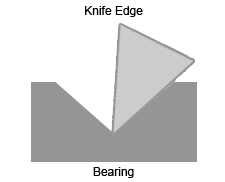 This platform assembly pivot bespeak, similar the main residuum arm pin point, consists of a knife edge and bearing. This provides an almost friction gratuitous point of contact that increases the accuracy of the balance.
This platform assembly pivot bespeak, similar the main residuum arm pin point, consists of a knife edge and bearing. This provides an almost friction gratuitous point of contact that increases the accuracy of the balance.
NOTE: The pocketknife edge and bearing are held in place and protected past a friction plate and are non openly visible.
When the torque on each side of the balance arm are nearly equal, the slightest touch or motility of air will cause the balance arm to oscillate. This hinders the user from determining if the balance is really balanced to zero. The triple beam residuum has a arrangement in place to stop these oscillations through the employ of a magnetic damper. The finish of the primary balance arm has an aluminum vane hanging beneath it. This vane moves between 4 magnets located in the extended arm of the base. The magnetic fields crusade a resistance to movement within the aluminum vane thus slowing down and finally stopping the beam oscillations. This resistance is to movement and non an bonny force thus no added torque is applied or diminished by the dampers and the resultant balance point is not contradistinct.




whitmoregrooduchere2002.blogspot.com
Source: https://us.ohaus.com/en-US/Tutorials/Triple-Beam
0 Response to "You ll Need to Slide the Weight Poises Until the Pointer Is at Zero Again"
Post a Comment